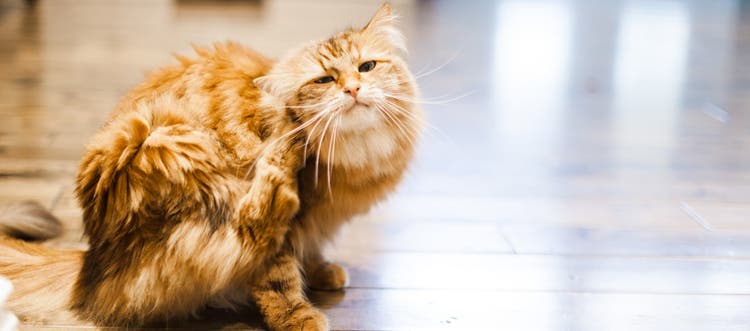What to do when your dog has fleas.
Whether your dog is a puppy or a senior, new to the family or an established pack leader, the risk of fleas stays the same. In fact, fleas are the number-one skin parasite of both dogs and cats. Read on to learn how to get rid of fleas on dogs and break the flea life cycle to prevent reinfestation.
How Do Dogs Get Fleas?
Facing a flea infestation on your dog may make you feel like you’ve let them down. But remember that it's not your fault as a pet owner, because fleas are stealthy: They can hitch a ride on your dog during neighborhood walks, puppy playdates, backyard business or even through human contact. Learn more about where fleas can come from.
How to Tell If Your Dog Has Fleas
While you may not know exactly where the fleas came from, you can tell if your dog has fleas if they show these signs:
- Increased scratching, biting and licking
- Loss of fur
- Flea dirt in fur that resembles black pepper or fine, dark dirt
- Brown parasites jumping or crawling in fur
- Pale gums
- Red bumps or scabs
- Behavior changes, such as restlessness or nervousness
How to Help Get Rid of Fleas on Your Dog
Fleas feed on your dog's blood, and once they have found this reliable food source, they move in and start rapidly reproducing. As soon as you've determined your dog has fleas, it's time to take action to stop the infestation in its tracks.
Treat the Fleas on Your Dog
If you see fleas on your dog, treat your pup with a product to kill the fleas quickly. Some flea treatment products kill the fleas on your dog on contact, such as specially formulated flea shampoos. You can also treat your dog with a flea spray or a fast-acting oral flea treatment — dead fleas are easier to wash away.
After flea treatment, use a flea comb to remove dead and dying fleas from your dog's coat. Dip the comb in a mixture of dish soap and water after using it to kill any remaining fleas on the comb. Continue to inspect and comb your dog weekly to keep tabs on the flea infestation.
A critical component to help get rid of fleas on your dog — and even more importantly, discourage them from returning — is to use a flea preventive year-round. Effective flea prevention can break the flea life cycle and last anywhere from 30 days to eight months.
Flea prevention treatments include:
- Collars
- Topical products
- Oral products
Keep in mind that preventives work best when used regularly year-round; simply applying for one or two months can leave your dog unprotected during the rest of the year.
Fact Check: Can I Put Baking Soda on My Dog for Fleas?
Some pet blogs advise dog owners to try killing fleas by using baking soda as a dry shampoo for dogs, or to sprinkle a baking soda and table salt mixture on carpets to dry out flea eggs and larvae. Unfortunately, baking soda has not been proven to kill fleas at any life stage or protect your pet from fleas. Products engineered to kill fleas are far more effective.
Treat the Fleas on All of Your Pets
Do you own more dogs? Or have a family cat? If one pet has fleas, they may all have fleas. To help prevent the infestation from spreading, apply preventives to all animals, including both indoor and outdoor pets.
Treat Your Environment for Fleas
If you have a flea infestation on your dog, there's a good chance you will also be fighting them in your home and yard. Fleas lay eggs on your dog that fall off when your pet sleeps on your sofa, lounges in your bedroom or roams your backyard. Adult fleas are only a small portion of a flea infestation, so it's important to treat your home and yard to help get rid of all flea life stages.
What to Do If You Can't Get Rid of Fleas on Your Dog
Battling a flea infestation can be a long process; it may take up to three months to adequately clear up. Even if it seems like you can't get rid of a flea infestation, don't get discouraged — repeat the above steps for as long as necessary to break the flea life cycle.
Make an Ongoing Plan to Treat and Prevent Fleas on Your Dog
Be sure to set reminders to administer treatment and prevention products, and always follow the products' recommended application schedules. Check your dog for fleas weekly and be on the lookout for new signs of itching and scratching. Staying alert and maintaining a regular flea prevention schedule can go a long way toward helping keep your dog protected.

Seresto® Flea & Tick Collar for Dogs
An easy-to-use, odorless, non-greasy collar that kills and repels fleas and ticks for 8 continuous months.

Credelio® (lotilaner)
As a trusted resource, your vet can provide additional information on how prescription-only Credelio can protect your dog from ticks and fleas all year long when taken monthly.

Advantage® Treatment Shampoo for Dogs & Puppies
A treatment shampoo that kills fleas and ticks on contact.

Advantage® Treatment Spray for Dogs
Kills fleas, ticks and lice. The active ingredients inhibit development of immature flea stages (preadult fleas and flea eggs) as well, which prevents them from growing into adult fleas that are capable of biting.
Indications for Credelio
Credelio kills adult fleas and is indicated for the treatment and prevention of flea infestations and treatment and control of tick infestations (lone star tick, American dog tick, black-legged tick, brown dog tick, and longhorned tick) for one month in dogs and puppies 8 weeks and older and 4.4 pounds or greater. Credelio is indicated for the prevention of Lyme disease infections as a direct result of killing black-legged ticks.
Important Safety Information for Credelio
Lotilaner is a member of the isoxazoline class of drugs. This class has been associated with neurologic adverse reactions including tremors, incoordination, and seizures. Seizures have been reported in dogs receiving this class of drugs, even in dogs without a history of seizures. Use with caution in dogs with a history of seizures or neurologic disorders. The safe use of Credelio in breeding, pregnant or lactating dogs has not been evaluated. The most frequently reported adverse reactions are weight loss, elevated blood urea nitrogen, increased urination, and diarrhea. For complete safety information, please see Credelio product label or ask your veterinarian.



